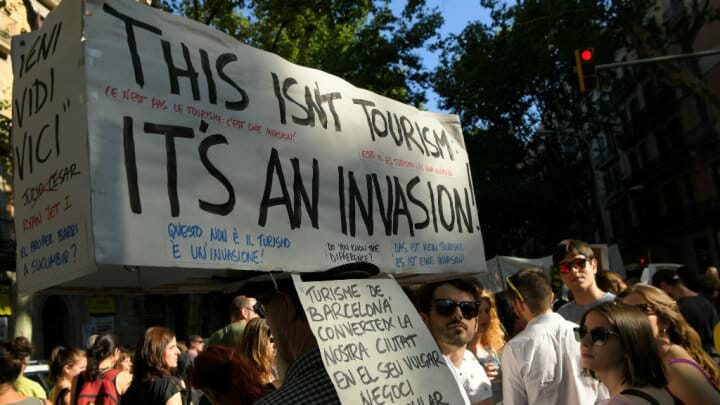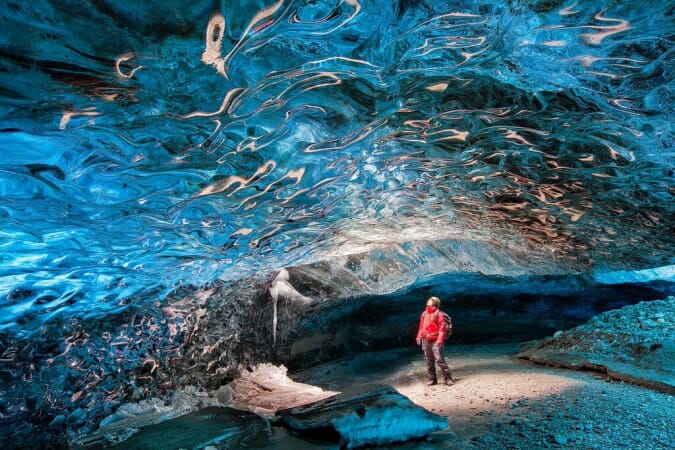The Challenges of Mass Tourism in the 21st Century
Working in the travel industry, it can be easy to forget that our responsibility extends further than just the people and businesses we sell services and products to. The bigger picture stretches beyond travellers, encompassing residents of popular destinations, natural ecosystems and, of course, the sustainability of the industry in general.
That's where the challenge of mass tourism rears its head. In our increasingly connected world, access to certain destinations is easier than it has ever been. Budget airlines, currency fluctuations and the sharing economy have made trips more accessible to more people. Countries like Iceland and cities such as Barcelona have effectively gone viral. There are no secrets anymore.
A recent Skift documentary took a closer look at the escalating situation in Barcelona, where locals are growing increasingly frustrated at the quantity of tourists flocking to the city. The Catalan capital has become the third most popular city in Europe, after London and Paris.
A growing number of residents are concerned that the high concentration of tourists is pushing up house prices, negatively impacting their lives and well-being and rendering parts of the city overcrowded and uninhabitable.

Skift's latest documentary: Barcelona and the Trials of 21st Century Over-Tourism
And this feeling is coming to the surface all over Spain, which has traditionally been one of Europe's most popular destinations. The number of visitors to Spain hit a record high in 2016 of 75.3 million, according to the Minister for Energy and Tourism, Alvaro Nadal. Last year was the fourth consecutive record year, as tourist numbers were boosted by security concerns in the Mediterranean from Turkey to north Africa.
Frustration with tourism has not come out of the blue. In a protest in Barcelona in June, one demonstrator held a banner that read: “Tourist flats displace families".
Protest group Arran has carried out events in Valencia and the Balearic Islands in recent weeks. In Palma de Mallorca, protesters smashed windows at a restaurant and set off smoke bombs before raising a banner declaring in English that, “Tourism is killing Mallorca”.

A similar demonstration is planned in foodie capital San Sebastian on 17 August, due to how tourism represents “precariousness” and “exploitation” for the young.
Are these mass tourism numbers sustainable?
Although mass tourism has come to represent a significant amount of income for cities like Barcelona, there is little doubt that its detriments are felt by locals. Areas such as the iconic Las Ramblas and the Sagrada Familia are no longer what they used to be; years of culture are being crowded and eroded by tourists eager for a quick selfie, by those looking for entertainment rather than something to appreciate.
Read more: In Depth With Barcelona's Foodie&Tours
Aside from overcrowded public areas and pressures on transport and infrastructure, accommodation is arguably the single biggest concern for residents in cities like Barcelona. A thriving rental market for short term accommodations has led to gentrification and higher long-term rents for residents.
The concern was so grave that in 2012, residents in Barcelona voted in a mayor whose main promise was to curb the rise in tourism. Whereas before there was little regulation regarding the set up of tourist accommodation, Ada Colau introduced a register and required online platforms such as Airbnb and Booking.com to sign up their apartments.
The key is to find a sustainable solution. The Skift documentary speaks to one boutique hotel owner who set up a hotel but opened the ground floor as a bar and restaurant, effectively redeveloping public space for locals at the same time as opening new rooms for tourists.
Could more community-focused travel companies like this be a solution?
Iceland: Another Example of Over-Tourism?
Much closer to home for us, Skift has also conducted investigations into the Icelandic travel scene, particularly looking at the growing number of visitors to Iceland and the sustainability of its booming tourism industry.
Just like in Spain, the boom in tourism to Iceland was predicated by the global financial crisis, which made visiting the land of ice and fire a lot cheaper than it once would have been and resulted in a surge of visitors keen to take advantage.
“Tourism is the factor that got us out of the recession and placed us where we are now,” said Ólöf Ýrr Atladóttir, director general of the Icelandic Tourist Board. “We couldn’t foresee this tremendous growth in interest for Iceland. That is also coupled with the fact that, in the last five years, the world has gone out of a recession. People are travelling more and more.”
There are also parallels in terms of the public reaction to increased numbers of tourists in Iceland and Spain. Both countries can partly attribute their recoveries from the economic crash to tourism, but locals are beginning to worry whether or not the benefits of the influx are being felt by all. Or if the detriments are worth it.
Increased tourism has led to a high demand for short term rentals, to the point where capacity is not enough. The result will be as familiar to locals in Reykjavik as it is to residents in the Catalan capital:
“There is a massive shortage of housing, There is a massive shortage of hotels,” said Sölvi Melax, founder of Icelandic car share startup Cario. “Renting long-term is getting more and more expensive. And that’s because people are going [with] short-term rentals.”
Huge changes over a relatively short period of time have perhaps caught city officials on the back foot. After all, it's hard to encourage a blossoming industry at the same time as keeping things sustainable and under control.
Read more: In Depth With Zen Resort Bali
The public's perception is partly because tourism is an industry like no other. It's brash and in your face; there's no escaping it. “We are just realizing what tourism is. It’s a totally different industry from all others,” said Atladóttir, comparing tourism to fishing:
“You can go out and fish, and you go and get your fish, and then come back. There’s somebody in the factory that prepares it, and then it’s sold. That, of course, is a tremendous economic impact, but then everybody goes home. The fish aren’t bothering you out in the streets asking where the restaurants are, and aren’t using your buses or utilizing a lot of the public goods. They aren’t sitting in your swimming pools.”
Just as in Barcelona, creaking infrastructure is struggling to meet the demands of rising numbers of tourists. To the point where government officials are considering airport entry fees, road tolls, and other types of taxes to fund improvements.
There could eventually be a cap on the number of visitors per year. While that may seem like a dramatic move, part of the allure for visitors to Iceland is the opportunity to see the natural world at its finest. Instead of being known for cathedrals (although Reykjavik has a spectacular one) and architecture, Iceland's popular sights include glaciers, the northern lights and volcanic landscapes.
Preserving these for future destinations of tourists and residents is understandably a priority. Keeping Iceland's nature intact is vital to any tourism going forwards, not just an ethical necessity.
Read more: Our Deep Dive into Sustainable Travel
Changes are required at a national level to deal with mass tourism
If there's one thing we can take from the situations in Spain and Iceland, it's that this kind of problem requires solutions at a national level.
Despite the fact that increasing tourism has brought with it prosperity and development to both countries, there is a lingering sense that residents' best interests are being overlooked in the pursuit of industry growth. This is reflected in rising costs of living, rapid changes to what were once established communities and iconic sights being overrun with tourists.
The challenge is to develop sustainable tourism practices that bring the same benefits but welcome international travellers in a more harmonious way: putting in place sensible sustainability measures without putting off tourists. Finding the right balance is vital, especially in countries that have quickly seen tourism grow to be a crucial part of the economy.
Taxes on tourists in the form of entry visas; caps on visitor numbers every year; quotas and ticketing on certain landmarks; more investment in under-pressure infrastructure... all of these are steps that local authorities could take to effectively deal with the problems that come with high levels of tourism.
There's also a need to keep residents onside by educating them about the benefits that tourism brings and giving them tangible access to those benefits.
Perhaps putting limits or taxes on tourism in the short term is the best way to solve problems around infrastructure, capacity and resident's concerns. Just as fishing quotas in the 1980s helped return Iceland’s fish stock to sustainable levels, maybe something similar could be done with the booming travel industry. Sometimes you have to take a few steps back and readjust your path to move forwards in the right way.

But what can travel operators do in the face of mass tourism?
Let's not kid ourselves: the primary motive for the majority of travel service providers is to make a profit from tourism. That can lead to a situation where short term growth and dollar signs are put ahead of sustainability.
However, travel operators would do well to take a step back and think about the long-term impact of mass tourism. In cities like Barcelona, excessive tourism threatens to overrun the local culture that makes it such an enticing destination in the first place. But this point is perhaps more significant to destinations popular because of nature. In countries like Iceland, sheer footfall could have a detrimental effect on the natural sights that make it so popular.
With that in mind, perhaps operators can shift to focus on smaller, more upscale tour groups with more focused itineraries. That way the heavy footfall of budget tourism can be reduced without necessarily hitting operators' bottom lines.
It's up to governments and travel operators to work together to ensure that tourism remains sustainable. Without progressive measures, some of our mose treasured destinations could lose the heart and soul that made them popular in the first place.